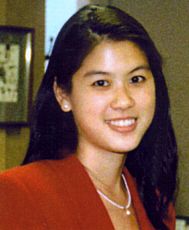Killing of Joyce Chiang
Joyce Chiang | |
|---|---|
 | |
| Born | December 7, 1970 |
| Died | c. January 9, 1999 (aged 28) Washington, D.C., U.S. |
| Education | Smith College (BA) Georgetown University (JD) |
| Relatives | John Chiang (brother) |
Joyce Chiang (
Life
Joyce Chiang was one of four children and the only daughter of Taiwanese immigrants raised in Chicago and in Southern California. Her three brothers are John Chiang, who became Controller of the State of California in 2007 and Treasurer of California in 2015; Robert Chiang; and Roger Chiang, who is currently the Executive In Charge at the television show America's Most Wanted and in 1999 lived with Joyce and was working for the U.S. Department of Housing and Urban Development.[1][2][3]
Chiang attended
Disappearance and death
On January 9, 1999, the day of Chiang's disappearance, she had met with several friends for a movie and dinner, and one of those friends offered her a ride home. Chiang asked her friend to make one quick stop at the Starbucks at the intersection of Connecticut Avenue NW and R Street NW. Chiang told her friend that she would walk the four blocks home from the coffee shop, but she never made it to her apartment. Her brother Roger was her roommate and reported her missing. Because Chiang was a federal employee, the FBI took the lead in investigating the case.[1]
A couple walking through Anacostia Park the next day found Chiang's billfold and turned it in to park police, who filed it in the park's lost and found. Four days later, the couple recognized Chiang's photo in media coverage and alerted the FBI, who arranged a search of the park and discovered her apartment keys, video and grocery cards, and gloves. The jacket in which Chiang was last seen was also found, torn down the back.[3]
During the three-month span in which she was missing, a candlelight vigil was held every Saturday night in Dupont Circle. Her brother Roger was instrumental in several televised and print appeals for more information on her case and disappearance.
Three months after the disappearance and 8 miles (13 kilometers) away, a canoeist on the
Speculated connection with Chandra Levy disappearance and promotion of suicide theory
In addition to the Congressional intern connection, Chiang had lived only four blocks away from where
In 2001, at the height of the media frenzy surrounding the disappearance of Chandra Levy, police attempted to discourage a serial killer theory by stating that Chiang had committed suicide. Chiang's family turned to the media to dispel that notion.
Later developments in 2011
In January 2011, WTTG-Fox 5 reported that the police had solved Chiang's murder, identifying two suspects who had attempted to rob her on the night she disappeared.[6]
In May 2011, D.C. police held a press conference in which they said that Chiang had not committed suicide, but was instead the victim of a
Remembrances
The Joyce Chiang Memorial Scholarship was established with the help of her family, to support one student each year with an internship at the Asian American Justice Center (AAJC) in Washington, D.C.[8]
The Joyce Chiang Memorial Award was established at Georgetown University Law Center by her friends and colleagues. It supports "an evening student with a demonstrable commitment to public service."[9]
See also
- List of solved missing persons cases
- List of unsolved murders
References
- ^ a b Dean, Eddie (July 30, 1999). "The Murder Victim Next Door". Washington City Paper. Retrieved April 9, 2012.
- ^ Hotchkin, Sheila (March 28, 1999). "Chiang's Personal Ordeal Clouds Election Victory". Los Angeles Times. p. B1.
- ^ a b c d e f g Gilchrist, Aaron (May 13, 2011). "Serial Rapists Killed Joyce Chiang: John Walsh". NBC4 Washington. Retrieved April 9, 2012.
- ^ Hsu, Spencer S. (January 9, 2000). "Remembrance Planned for INS Lawyer". The Washington Post. p. C9.
- ^ The Hon. Howard Berman (April 13, 1999). "Heartbroken Farewell to Joyce Chiang". Congressional Record. 145 (50): H1897–H1898.
- ^ Wagner, Paul (January 25, 2011). "New Developments in Death of Prominent Federal Attorney Joyce Chiang; Vanished from Dupont Circle 12 Years Ago". WTTG Fox 5 News / myFOXdc.com. Retrieved April 9, 2012.
- ^ a b Wagner, Paul (May 12, 2011). "2 Men Named in Mysterious Disappearance, Death of Joyce Chiang". WTTG Fox 5 News / myFOXdc.com. Retrieved April 9, 2012.
- ^ Asian American Justice Center. "Development: Support AAJC: Contribute to a Scholarship". Archived from the original on February 4, 2012. Retrieved April 9, 2012.
- ^ Georgetown University Law Center. "2011–2012 Georgetown Law Bulletin" (PDF). p. 198. Archived from the original (PDF) on October 16, 2011. Retrieved April 9, 2012.
